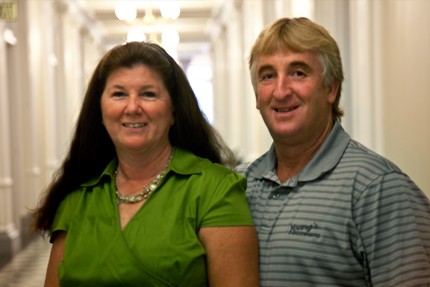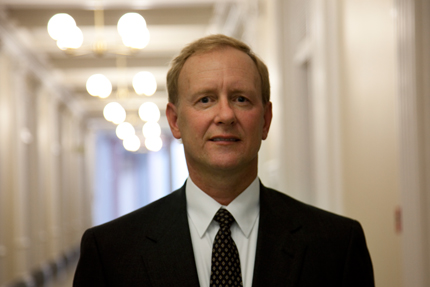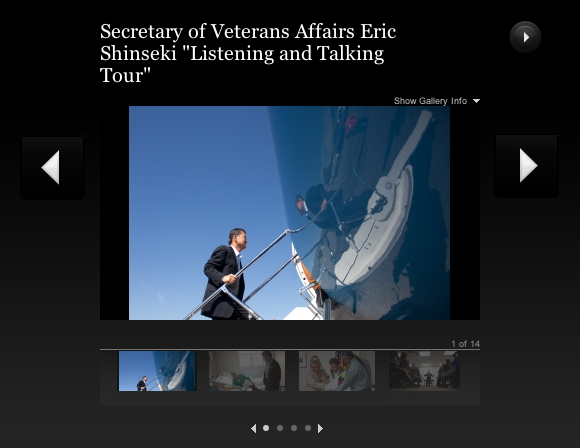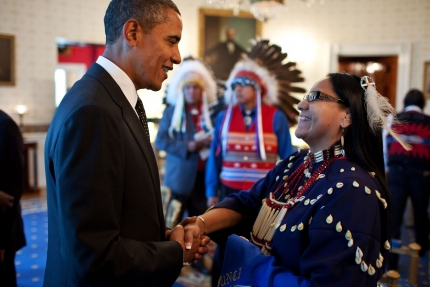Related Rural Blog Posts
Rural Veterans and the Tyranny of Distance
Posted by on August 3, 2011 at 8:00 AM EDTAt the Department of Veterans Affairs, Secretary Shinseki often talks about the tyranny of distance – the distance that often separates Veterans from care at their nearest VA medical facilities. For about 3.3 million Vets, or 41 percent of the total enrolled in VA’s health care system, distance is more than a challenge. Distance can mean rural Veterans don’t have access to the care and services they’ve earned.
Secretary Shinseki made it clear – this summer, he wanted to hear from Veterans in the hardest to reach places. “I know from previous experience that sitting in Washington with a 2,000-mile screwdriver trying to fine tune things at the local level never works,” he said. So, we hit the road to learn firsthand.
From the plains of North Dakota and Montana to the isolated island of Guam, Veterans from rural areas talked with Secretary Shinseki about what’s working and what the department can do better. To many Veterans, it was clear VA has shifted its approach to be more accessible. But we also quickly learned that standard definitions like “urban, rural, and highly rural” may not be exact enough. Often, “remote, extreme rural, and inaccessible” is more accurate.
The “inaccessible” category would definitely include Kwigillingok, Alaska, or Kwig, located in the far reaches of Central Yup’ik near the Bering Sea. On Memorial Day, Secretary Shinseki visited Kwig to meet and honor living members of the Alaska Territorial Guard, who served bravely during World War II. No roads lead to Kwig, so the trip wasn’t easy. We hopped on a flight in Anchorage, and connected in the small town of Bethel – about 1,000 miles roundtrip. When we finally landed on the dirt landing strip in Kwig, villagers on all-terrain vehicles appeared from all over to give us rides to the village center.
White House Roundtable Meeting with Rural Leaders
Posted by on July 28, 2011 at 4:53 PM EDTEd. Note: Cross-posted from the USDA blog.
This week, I led a meeting in the Roosevelt Room at the White House with leaders of a host of rural organizations to discuss the White House Rural Council. The White House Rural Council, which was established by President Obama on June 9, 2011, will build on this Administration’s unprecedented efforts to spur job creation and economic growth in rural America. Along with Jon Carson, the Director of the Office of Public Engagement and Doug McKalip of the White House Domestic Policy Council, we discussed the Council’s efforts to improve coordination among federal agencies. We focused in on ways to help better leverage existing federal resources in rural America – and on how to facilitate private-public partnerships that can move the needle in building stronger rural communities.
The meeting was a chance for me to listen to our rural partners on the issues that need to be addressed and discuss potential solutions. Some of the key issues raised included the need to coordinate more with our federal partners on health care, broadband, and other critical infrastructure; how to increase the availability of capital and lending to rural businesses and families; efforts to remove barriers to young and beginning farmers; and strategies for establishing better partnerships with states, tribes, local governments and the private sector. Many of the leaders gathered also expressed appreciation for the renewed focus on rural America and the importance the White House has placed on these issues.
Winning the Future by Supporting Local Innovation
Posted by on July 28, 2011 at 3:15 PM EDTToday, I was proud to announce that we are making $95 million available in Regional and Community Challenge grants to support local efforts to build more livable and sustainable communities that ensure that all Americans can afford to live in places with access to employment, schools and public transit options.
But that’s not all these efforts represent. They show that President Obama recognizes that in world where flexible workplaces win, where flexible minds win and where flexible economies win, communities need a flexible federal partner that’s responsive to local needs.
With this funding, we’re building on the $170 million in grants we awarded last fall with our partners from the Department of Transportation to offer a different kind of partnership to local communities. Rather than the “one-size-fits-all” rules and regulations that too often ignored the unique needs of every community and created barriers to growth, the Partnership for Sustainable Communities is helping drive innovation at the local level and leveraging the public, private, and philanthropic investment communities need to thrive.
Learn more about Rural, Urban PolicyCelebrating the One Year Anniversary of the Tribal Law and Order Act
Posted by on July 27, 2011 at 3:34 PM EDTThis week marks the one-year anniversary of the enactment of the Tribal Law and Order Act (TLOA), a comprehensive law that is improving the federal government’s ability to work with Indian tribes in the investigation and prosecution of crime impacting tribal communities. President Obama was proud to sign the TLOA, as it fills key gaps in our criminal justice system that for far too long were not addressed.
Lisa Iyotte, a Lakota woman, a survivor, shared her personal story of her brutal rape that occurred in her home on a reservation as her young daughters watched. The man who raped her was never prosecuted for his crimes against her. During her introduction of President Obama at the TLOA signing ceremony, she said, “if the Tribal Law and Order Act had existed 16 years ago, my story would be very different.” As President Obama put it, “when one in three Native American women will be raped in their lifetimes, that is an assault on our national conscience; it is an affront to our shared humanity; it is something that we cannot allow to continue.”
TLOA helps us better address public safety in tribal communities. Specifically, TLOA gives tribes greater sentencing authority, improves defendant’s rights, establishes new guidelines and training for officers handling domestic violence and sex crimes, strengthens services to victims, helps combat alcohol and drug abuse and helps at-risk youth, expands recruitment and retention of Bureau of Indian Affairs and tribal officers and gives them better access to criminal databases.
Coming Together to Rebuild
Posted by on July 22, 2011 at 4:03 PM EDTEd. Note: Champions of Change is a weekly initiative to highlight Americans who are making an impact in their communities and helping our country rise to meet the many challenges of the 21st century.

Glen and I had a wonderful time in Washington DC on July 6th. Everyone was courteous and made us feel comfortable and at ease. We were also thrilled that we got to meet President Obama and talk with him. Secretary Vilsack also impressed us with his knowledge of agricultural rules. All in all it was exciting to know that the Department of Agriculture wanted our input. We felt honored to be invited to the White House.
We have always said that hard work pays off. We have been a family-run business for over thirty years, with four generations at our greenhouse: Elma (first owners), Glen (Elma’s son), Benjamin (Glen’s son), and Carson (Ben’s five year old son). It started with our mother and father, Earl and Elma Young, growing and selling vegetables. Then we began to sell flowers. The first time we ever bought hanging baskets to sell, we bought eight fuchsias. We thought we had bought too many hangers and were going to get stuck with them. Now, after thirty years, we sell four hundred fuchsia hangers and over twenty thousand other hangers. Our greenhouses cover a total of two acres.
In the fall of 2009, a tornado came and tore through our greenhouses, leaving only four standing. The four left standing had to be torn down because the tornado shifted the bars and they were not safe. We were all on vacation the day the tornado came through. When we came back, we took a deep breath and knew we had to rebuild, and that we had to rebuild before the ground froze, because metal poles had to be put into the ground for the frames.
Learn more about RuralReducing Our Individual Carbon Footprints
Posted by on July 22, 2011 at 12:54 PM EDTEd. Note: Champions of Change is a weekly initiative to highlight Americans who are making an impact in their communities and helping our country rise to meet the many challenges of the 21st century.
 After witnessing some very innovative renewable energy projects in my travels around the world, I thought: why can't I implement these principles in our family business? We have always had a personal commitment to lower our energy consumption, and that commitment set us on a path that brought me to Washington D.C. for the Rural Champions of Change forum.
After witnessing some very innovative renewable energy projects in my travels around the world, I thought: why can't I implement these principles in our family business? We have always had a personal commitment to lower our energy consumption, and that commitment set us on a path that brought me to Washington D.C. for the Rural Champions of Change forum.My wife Tara and I achieved our goal by effectively putting our vision into action. Our contractor Dixon Power and I came up with a plan to take the energy needs of our horse boarding and event facility towards a self-supporting operation via sustainable and renewable energy. We soon realized that the hurdles we faced would require help from the Federal government, State government, the local county, and our personal banking institution.
We are proud of the outcome, particularly being the first at this endeavor. The obstacles that we encountered in our project were outweighed against the threats posed by climate change, dependency on foreign oil, and the need to do the right thing for the community that we live in.
While we did this for our personal energy consumption, now we understand that if one person starts to make a change, it can lead the entire community benefiting. After visiting with the other Champions of Change nominees, I have a new found clarity coupled with a deeper understanding of the challenges that we all face in our personal quest to lower our overall energy consumption. My wife and I can actually now begin to imagine what we can do as a nation, being that just two individuals from a small rural community can take the lead by reducing our individual carbon footprints on our personal and professional energy consumption.
Learn more about Rural
- &lsaquo previous
- …
- 19
- 20
- 21
- 22
- 23
- 24
- 25
- 26
- 27
- …
- next &rsaquo

